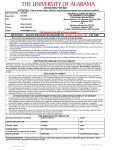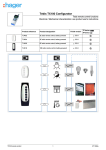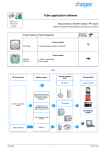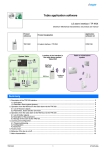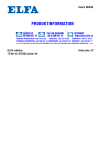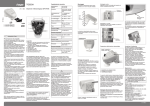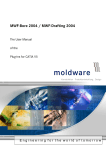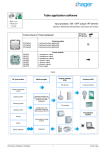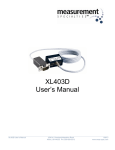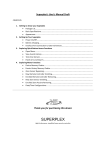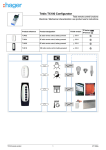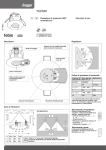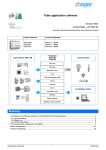Transcript
Technical characteristics GB TG 053 Supply voltage 24 V DC or 20 V AC Weather station KNX Consumption max. 100mA, Residual undulation 10% 6T 7343.a N tebis TP RF 20V AC 24V DC Bus 30 V / GB All control events, time programs, and the 8 logical inputs (such as communication objects) can be used as inputs of logical gates. The output of each gate can be configured in 1-bit or 2 x 8-bit format. The KNX is configured using the ETS software. In version ETS 3 and higher, the settings menus of the TG 053 feature an optimal graphical presentation. Working temperature -30°C to + 50°C vertical post Half-crescent facing The weather station must be installed on a wall or a vertical post. Protection class IP44 Dimensions 96 mm x 77 mm x 118 mm (lxLx h) Weight ~146g Heating The weather station TG 053 measures the outdoor temperature, the wind speed and light. It detects rain and daylight fall, and receives date and time by radio signal DCF77. Moreover, it calculates the exact position of the sun (azimuth and elevation) using the site coordinates, the date and the time. The weather station TG 053 includes an annual clock and a weekly clock. The clock channels can switch the outputs using the communication objects. The weekly clock controls up to four different time settings for each day of the week. The annual clock can be used to define up to three periods in the year with two daily ON/OFF commands for each of them. The switching times can be defined by settings or the communication objects. The weather station also has 8 logical AND gates and 8 logical OR gates, each with four inputs. EIB/KNX +/- plug-in bus terminal or Installation on a post: apply the curved side of the support on the post with the half-crescent facing downwards. Preparing the weather station Cover with rain sensor 1,2 Watt (24 V) Make sure that the weather station is horizontal. Clicking the cover into place Plate Lower part of the unit Temperature sensor: Measurement range -40°C to +80°C Resolution 0.1°C Installing the support The weather station TG 053 includes a support for installation on a wall or a vertical post. The support is clipped to the rear of the unit. Wind sensor: Legend: 1- Connector for the rain sensor cable built into the cover of the unit. 2- Spring-loaded terminals for the 24 V DC/20 V AC power supply for rigid conductors measuring up to 1,5 mm² or for flexible conductors. 3- Opening for the power supply cord. 4- Opening for the KNX bus cable. 5- Position of the KNX connector (+/-). 6- Physical address button. 7- Physical address LED. 8- Adjusting screw for the DCF77 antenna. 9- DCF77 reception light. Measurement range 0 m/s to 70 m/s Precision < 10% of the measure value Light sensor: Measurement range 0 Lux to 150.000 Lux Precision +/- 10% of the measure value Two articulated supports are available as option (TG 353 and TG 354) for wall mounting, on post or beam. Detach the support by unscrewing with a screwdriver. The screws retaining the support are located on the left and right as shown in the diagram. Positioning the DCF77 antenna The antenna that receives the DCF77 signal for the date and time is in the unit, under the electronic board. The adjusting screw (see legend num. 8) can be used to move the antenna through 180° and to position it. Reception is OK when the DCF77 reception light (see legend num. 9) flashes in a regular manner once a second (the light stops flashing after 59 seconds). The light can be prevented from flashing in the ETS software. Never start up a weather station that shows signs of damage. If use without danger is not possible, switch off the system and protect it against an accidental restart. The weather station must be used as a fixed system. It must only be started after all the installation works have been completed and in an environment designed for this purpose. Hager refuses any liability for possible changes to standards that may be made after the publication of these instructions. Location Select a clear site that allows for correct measurements by the wind, rain and sun sensors. South direction is advised for correct measurement of brightness level. The weather station must never be installed beneath structures from which water may fall onto the rain sensor after the end of the precipitations (rain or snow). The weather station must never be placed in the shadow of a building or trees. Arrange a space of at least 60 cm under the weather station to allow for correct wind measurements and to prevent snow from covering the sensor. The presence of metal structures or large sheet metal pieces behind or near the weather station will affect the quality of reception of the DFC77 radio clock. Please allow for this when installing the TG 053. Other factors may also interfere with or affect the reception of the DCF77 signal, such as magnetic fields, transmitters or radioelectrical interference from fluorescent light tubes, illuminated signs, power supplies with switches, etc. Installing the weather station Close the unit by raising the cover on the lower part. The cover is clipped onto the lower part on the left and right. A "click" can be heard. Unclip the support by pushing it downwards. Attach the support vertically on a wall or a post. Half-crescent facing Lock mechanism Installation on a wall: Apply the flat side of the support against the wall with the half-crescent facing upwards. 1 6T 7343.a The cover of the weather station is clipped to the lower edge of the unit on the left and right. Remove the cover of the weather station. Proceed with care to avoid detaching the cable between the rain sensor built into the cover and the electronic circuit board. Pass the power cables and the KNX bus through the rubber seals on the lower part of the weather station, then connect the L/N power cables and the KNX bus (+/-) to the terminals provided. Installation and startup Only qualified technicians must install, check, start up and repair the appliance. Make a note of all the lines to be installed with the appliance switched off and protect them against risks of being powered up. The weather station is designed only for the uses described in this user manual. Any non-compliant changes or breaches of the specifications in this user manual will render the warranty null and void. Check that the appliance is complete and in perfect condition (no mechanical damage) immediately after unpacking it. If damage has occurred during transportation, inform the supplier immediately. Slide the top of the unit onto the previously installed support. The pins on the support are clipped in the rails of the unit. Remove the weather station by pulling the unit upwards until it is unclipped from the support. Unclip the support and pull it upwards Rain sensor: Presentation The compact TG 053 unit houses the sensors, data processing electronics and the connection with the KNX bus. The values measured are sent to the KNX bus as physical values (2x8 bits ou 1 bit). The position of the sun is calculated using the date, time and the settings downloaded in the appliance (site coordinates) and may then be sent on the KNX bus. Each output has communication objects indicating the measured and calculated values. The state of outputs depends on one or more levels. Thresholds can be defined by settings or the communication objects. Bus connection Wall Check that the cover and the lower part are clipped into place. The illustration shows the closed weather station, seen from below. 2 Recommendations for installation Do not open the weather station, otherwise rain water may enter the unit. Just a few drops of water can damage the electronics. Make sure that the connections are correct. Poor connections can destroy the weather station or any connected electronic appliances. When installing the weather station, make sure that the temperature sensor (the small plate in the lower part of the unit) is not damaged. Take care not to damage the cable between the electronic board and the rain sensor by pulling or bending it. The wind speed measurements and the associated switch outputs only start working 60 seconds after the station is switched on. Maintenance Regularly (at least twice a year) check that the weather station is clean and clean it if necessary. Severe soiling can affect the operation of the wind sensor, provoke permanent rain signals or inhibit the sun detection function. For safety reasons, switch off the mains power supply before servicing or cleaning the weather station (switch off the circuit breaker). Transmission protocol The use of chopped power supplies can affect the quality of reception of the DCF77 radio clock. The DCF77 signal is subject to interference. It is possible that no DCF77 radio signal is received for long periods. The time from the DCF77 clock must therefore only be used for synchronisation purposes with a clock operating on the KNX bus. Preferably use second 0. The EMC tests of the appliance were conducted according to the following standards: Radioelectric interference: EN 60730-1:2000 Partie CEM (23, 26, H23, H26) (threshold value: B) EN 50090-2-2:1996-11 + A1:2002-01 (threshold value: B) EN 61000-6-3:2001 (threshold value: B) Immunity to radioelectric interference: EN 60730-1:2000 Partie CEM (23, 26, H23, H26) EN 50090-2-2:1996-11 + A1:2002-01 EN 61000-6-1:2004 The conformity of the product with the standards listed above has been tested by an accredited EMC laboratory. 6T 7343.a

